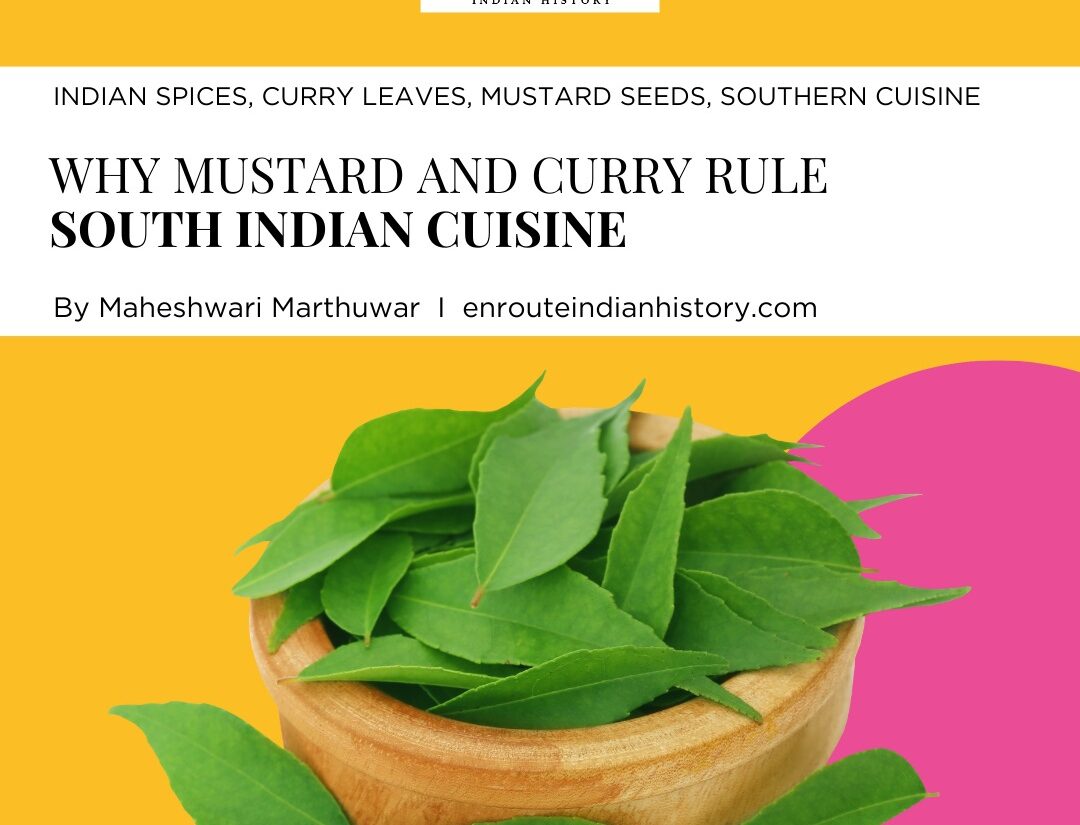
Indian food is renowned worldwide for its incredible taste and flavours. The unique blend of spices gives it a distinct aroma and colour that sets it apart. These flavours are exclusive to Indian cuisine and cannot be found anywhere else. The main purpose of using spices in Indian food is to enhance the overall taste of the dish. Spices also play a significant role in various home remedies. In Southern Cuisine, curry is incomplete without the addition of spices. It is not just a garnishing element but an essential part of the dish. Interestingly, in the past, it was customary to remove curry leaves from the dish without even tasting it. “Mustard seeds sizzling in hot oil…into it go chopped onion and curry leaf… “sssssshh”… However, Indian cuisine experts, especially in South India, have made it a habit to include curry leaves in their daily diet. Along with mustard seeds, curry leaves are considered essential ingredients in Southern Cuisine. They not only add to the vibrant appearance and spicy flavour but also offer numerous health benefits. In this article, we will explore the significance of curry leaves and mustard seeds in Southern Cuisine and their positive impact on our daily lives.

( Source : Curry Leaves And Mustard Seeds, Nimsaraakash,https://www.freepik.com/author/nimsaraakash )
The curry leaf tree, scientifically known as Murraya koenigii, is indigenous to India, Sri Lanka, Bangladesh, and the Andaman Islands. Over time, it was introduced to other regions by Indian migrants and is now cultivated in various parts of the world where Indian immigrants have settled. These leaves are widely grown and are particularly associated with Southern Cuisines. The use of curry leaves as a flavouring agent for vegetables can be traced back to early Tamil literature from the 1st to 4th centuries AD. Their usage is also mentioned in Kannada literature from a few centuries later. Curry leaves continue to be closely linked with South India, where the term ‘curry’ originated from the Tamil word ‘kari’ meaning spiced sauces. Another name for curry leaf in India is kari-pattha.

( Sources : Krati Purwar, 5 Types Of Tadka To Add A Burst Of Flavour To Dal,
https://www.herzindagi.com/amp/recipe-tips/types-of-tadka-to-add-a-burst-of-flavour-to-dal-article-211358 )
On the other hand, mustard seeds have a long history as one of the oldest recorded spices. Sanskrit records dating back to around 3000 BC mention mustard seeds, which were among the first crops to be domesticated. Originally, mustard referred to the condiment itself, and the word is derived from the Latin term “mustum.” The Romans had a special condiment called mustum ardens, which was made by mixing ground mustard with the expressed juice of grapes or other fruits, resulting in a hot and pungent flavor. The Romans’ fondness for mustard spread throughout Europe, where it became popular for seasoning meat and fish. In addition to its culinary uses, mustard seeds were also recognized for their medicinal properties, as Pythagoras mentioned them in 530 BC as a remedy for scorpion bites. Mustard seeds were even used in ancient Egypt for entombing their kings. Some believe that mustard was used to mask the taste of spoiled food. Indian mustard was introduced to North Eastern India from China. Mustard and rape (a related crop) thrive in temperate climates and are primarily cultivated in China, India, Pakistan, Canada, France, Poland, and Germany. India holds the distinction of being the world’s largest producer of mustard.
The curry leaf tree, typically reaching heights of 4 to 6 metres, is known for its potent leaves. Rich in antioxidants, curry leaves have been utilized in Ayurveda, a traditional Indian medicinal practice, for centuries. These leaves have been employed in the treatment of various ailments such as heart disease, cancer, type 2 diabetes, infections, and inflammation. A common remedy for alleviating morning sickness involves blending curry leaf juice with fresh lime juice and sugar. Curry trees thrive in well-drained soils, preferably in locations shielded from strong winds. While indigenous to the Indian subcontinent, the mustard plant is an upright, slender, and branched annual herb that typically grows to a height of 3-5 feet. The leaves of the mustard plant are simple, alternate, and lyrate with dissected margins. The leaf surface is covered with numerous fine, hairy structures. Each fruit of the mustard plant usually contains 20-30 small, rounded, yellowish-brown, or black seeds attached to the replum. These seeds exhibit distinct reticulation on their surface and are composed of 20% protein and 30-45% oil. Upon reaching maturity, a strong and repelling odor may emanate from the mustard field.
How Do I Cook with Curry Leaves And Mustard Seeds?
“In India, every dal (lentil) dish needs a tadka (tempering) of fragrant spices and curry leaves to be truly delicious. The sizzling tadka of curry leaves, mustard seeds, cumin seeds, and red chilies in hot ghee or oil brings a burst of flavor and aroma to the humble yet comforting dal preparations”.
Curry leaves and mustard seeds are essential components of Indian cuisine and traditional medicine. In Indian cooking, they are typically used in the initial stages of preparation, where they are fried alongside vegetable oil, mustard seeds, and chopped onions. Another method of cooking with curry leaves involves adding them at the beginning of the cooking process. Each leaf is detached from its stem and fried in hot oil, allowing its essential oils to infuse into the cooking oil, thereby imparting a rich flavour to the dishes. Curry leaves and mustard seeds are versatile and can be used in various dishes such as vegetable, bean, seafood, or meat preparations. They are commonly added to stews, South Indian soups like rasam and sambar, lentil dishes, chutneys, and even the popular appetizer, samosas. Additionally, curry leaves and mustard seeds are often combined with other spices and ingredients to create pre-mixed powders or masalas, which are used for marination or as a powder in dishes like fish curry, dry fish curry, egg curry, tamarind curry, kara curry (chilli curry), and fenugreek curry. These combinations enhance the aroma and flavour of the curry, making them integral to Southern Cuisine.

( Sources : Top view of Chilli (curry) Kulambu Masala, mainly used in Tamil nadu and named as kulambu Chilli (milagai) masala arranged in a black pan for frying with black background. https://www.shutterstock.com/image-photo/top-view-chilli-kulambu-masalamainly-used-1773473669 )

(Sources : Tamil Cuisine – Homemade Vatha Kulambu (A Spicy Curry Dish., https://www.shutterstock.com/image-photo/tamil-cuisine-homemade-vatha-kulambu-spicy-662584243 )
Curry leaves and mustard seeds are essential ingredients in South Indian cooking, adding a unique flavor and smell that is crucial to the region’s food culture. These ingredients have been important for centuries, showing how they have influenced local cooking traditions over time. Mustard seeds and curry leaves have a complex taste, with hints of citrus and nuts, which enhance a variety of dishes like curries and chutneys.
Both mustard seeds and curry leaves are used in vegetarian and non-vegetarian meals, giving them a special scent and taste that makes dining more enjoyable. Additionally, these ingredients have health benefits and are part of Ayurvedic practices, showing how they contribute to well-being in South Indian society.
The techniques used to preserve and grow curry leaves and mustard seeds ensure that they are always available for use in South Indian dishes. Whether they are dried, frozen, or freshly picked, curry leaves are a common ingredient in homes and restaurants. Overall, the lasting importance of curry leaves and mustard seeds in South Indian cuisine demonstrates how they have played a vital role in shaping the region’s diverse food traditions.
References :
- Bhusal Dipika & Dhirendra Pratap Thakur, Curry Leaf : A Review, Reviews in Food and Agriculture (RFNA), Institute of Agriculture and Animal Science, Paklihawa Campus, Tribhuvan University, Nepal, March 2021, pp – 36-38.
DOI : http://doi.org/10.26480/rfna.01.2021.36.38
- Culinary Significance of Curry Leaves in South Indian Cuisine, November 20, 2023.
https://www.savorysuitcase.com/culinary-significance-of-curry-leaves-in-south-indian-cuisine/
- Dr. Singh Devashish, Mustard: Species, Origin, Botanical characters, Cultivation and Uses, Harishchandra Post Graduate College ,Varanasi, November 2020, pp – 1-5.
- Hrideek T K, Mustard, Kerala Forest Research Institute, January 2004, pp – 196-205.
https://www.researchgate.net/publication/280131369
- Mishra Rajesh Kumar, Curry leaves (Murraya koenigii Spreng.), Tropical Forest Research Institute, Jabalpur, MP, India, Van Sangyan (ISSN 2395 – 468X), Volume – 5 : No. 7&8, Issue : July-Aug., 2018, pp – 23-28.
https://www.researchgate.net/publication/327720917_Curry_leaves_Murraya_koenigii_Spreng
- Mittal Jitendra, Curry leaf (Murraya Koenigii) : a spice with medicinal property, MOJ Biology and Medicine, MedCrave Step into the World of Research, Volume 2 : Issue 3, November 21, 2017, pp – 236-256.
https://doi.org/10.15406/mojbm.2017.02.00050
- Shukl Aankit & Nagendra Yadav, Role Of Indian Spices in Indian History, Ankit Shukla et. al., / International Journal of Management Research & Review, ISSN: 2249-7196, IJMRR, November 2018, Volume : 8, Issue : 11, pp – 1-6.
https://www.researchgate.net/publication/365451144_ROLE_OF_INDIAN_SPICES_IN_INDIAN_HISTORY
- May 15, 2024
- 6 Min Read























